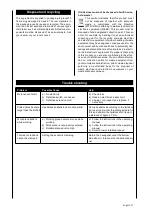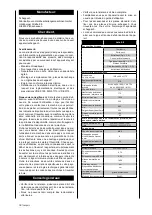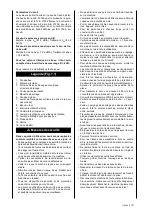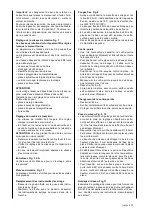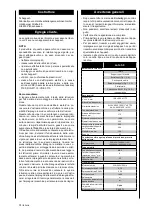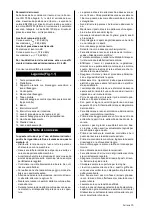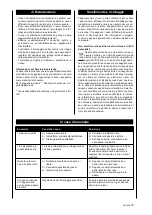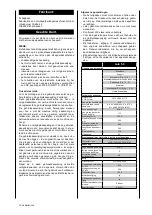
16 english
Centering of the workpiece (Fig. 12)
Centering the prepared workpiece is an important
operation to be performed before placing it into the
machine. Centering consists of measuring the middle
point of the workpiece and marking it with a center
punch.
Make a depression of 1.5 to 2 mm in the middle point.
If the workpiece has not been centered exactly, strong
vibrations will develop as a result of the imbalance. It
is possible that the workpiece could be hurled outward
as a result.
Note:
Exact centering of the workpiece produces
smooth concentricity.
While working with the turner
• Work with a rough workpiece should be conducted
at low speeds.
• Only after the wood has been pre-turned (the pre-
turning operation is complete once the basic form of
the workpiece as well as an even concentricity have
been achieved) can the speed be raised.
• The live center must be readjusted from time to time
with the hand wheel. This operation only should be
performed when the motor has been turned off.The
tailstock center should rest firmly in the wood.
• Turn the workpiece by hand to check if it rests se-
cured.
Marking of the workpiece
Sometimes the workpiece has to be taken out before
it has been completed. It is advantageous to mark the
workpiece and the driver with a pencil first.
When placing the workpiece back in the machine,
match the marks on the workpiece and the driver.
Specialized literature
Specialized shops offer appropriate specialized litera-
ture about wood turning. They can be a great help for
beginners in their work as well as a source of ideas
for experts.
m
Electrical connection
The installed electric motor is completely wired ready
for operation.
The customer’s connection to the power supply sys-
tem, and any extension cables that may be used, must
conform with local regulations.
Important remark:
The motor is automatically switched off in the event of
an overload. The motor can be switched on again after
a cooling down period that can vary.
Defective electrical connection cables
Electrical connection cables often suffer insulation
damage.
Possible causes are:
• Pinch points when connection cables are run
through window or door gaps.
• Kinks resulting from incorrect attachment or laying
of the connection cable.
• Cuts resulting from running over the connecting ca-
ble.
• Insulation damage resulting from forcefully pulling
out of the wall socket.
• Cracks through aging of insulation.
Such defective electrical connection cables must not
be used as the insulation damage makes them
ex-
tremely hazardous.
Check electrical connection cables regularly for dam-
age. Make sure the cable is disconnected from the
mains when checking.
Electrical connection cables must comply with the
regulations applicable in your country.
Single-phase motor
• The mains voltage must coincide with the voltage
specified on the motor’s rating plate.
• Extension cables up to a length of 25 m must have a
cross-section of 1.5 mm
2
, and beyond 25 m at least
2.5 mm
2
.
• The connection to the mains must be protected with
a 16 A slow-acting fuse.
Only a qualified electrician is permitted to connect the
machine and complete repairs on its electrical equip-
ment.
In the event of enquiries please specify the following
data:
• Motor manufacturer
• Type of current of the motor
• Data recorded on the machine’s rating plate
• Data recorded on the switch’s rating plate
If a motor has to be returned, it must always be dis-
patched with the complete driving unit and switch.
m
Maintenance
• Overhauls, maintenance work, cleaning, as well as
the elimination of any malfunctions must only be un-
dertaken after turning off the motor.
• All protective and safety equipment must be rein-
stalled immediately upon completion of any repair
or maintenance work.
• Clean and lightly oil the spindle thread of the tool
holder when changing tools.
• When possible, the tail stock sleeve should be re-
moved by unscrewing it, cleaned and then sprayed
with a dry lubricant. Grease the threaded spindle.
• Check the eccentric clamp of the tailstock as well as
the tool holder and adjust if necessary. In addition,
tighten the hex nut under the bracket.
• Check the drive belt and replace when necessary.
Service information
Please note that the following parts of this product are
subject to normal or natural wear and that the follow-
ing parts are therefore also required for use as con-
sumables.
Wear parts*: Carbon brushes, v-belt
* Not necessarily included in the scope of delivery!
Содержание 1902301901
Страница 2: ...Fig 2 Fig 1 2 A C D 3 1 4 5 15 9 14 13 10 11 2 Fig 1 1 12 6 8 7 ...
Страница 3: ...Fig 3 Fig 4 Fig 5 Fig 6 Fig 7 Fig 8 Klemmgriff Rastbolzen ...
Страница 4: ...Fig 11 Fig 9 Fig 10 Fig 12 L N PE L 0 R L1 Z2 L2 Z1 2 1 Motor Switch Fig 13 ...
Страница 115: ...international 115 ...
Страница 116: ...116 international ...
Страница 117: ...international 117 ...
Страница 118: ...118 international ...
















